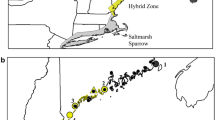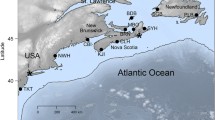Abstract
Habitat alteration has been implicated in driving hybridization between the sympatric migratory shads Alosa alosa and Alosa fallax. Morphological and molecular evidence is consistent with hybridization across the overlap** range of these species, but the temporal extent of hybrid occurrence and genetic consequences for populations have not been explored. Using eight nuclear microsatellite loci and samples collected between 1989 and 2008 in the Solway Firth (UK), we genetically identified hybrids, studied temporal changes in their frequency, and explored changes in allele frequencies of parental populations. These molecular data confirmed the hybrid status of individuals identified using morphology (number of rakers on the outer gill arch), and enabled separation of hybrids from purebred individuals. Mitochondrial cytochrome-b sequencing revealed the presence of two haplogroups, each predominantly occurring in one species. Heterospecific haplotypes were found in 22.3 and 12.8% of A. alosa and A. fallax individuals, respectively, consistent with backcrossing and suggesting that hybrids are fertile. On average, microsatellite-identified hybrids comprised 12.7% of all samples, but when individuals with cytonuclear discordance were also considered introgressed on average 25.4% of individuals were of hybrid ancestry. Overall, allelic richness remained largely unchanged within species, but there were declines in the inbreeding coefficient (F IS) of both species and episodes of significant temporal allelic frequency change. Hybrids sampled between 2004 and 2008 showed no evidence of lower fecundity relative to purebred individuals. Together, results suggest that hybridization between shad species in northern Europe is prevalent, and has been ongoing over at least two decades. The challenge is now to understand the extent to which observed patterns are linked to immigration from other populations, and the mechanisms that have prevented species collapse despite apparent hybrid fertility and longstanding introgression of neutral markers.






Similar content being viewed by others
References
Alexandrino P, Faria R, Linhares D, Castro F, Le Corre M, Sabatié R et al (2006) Interspecific differentiation and intraspecific substructure in two closely related clupeids with extensive hybridization, Alosa alosa and Alosa fallax. J Fish Biol 69(Supp B):242–259
Allendorf FW, Leary RF, Spruell P, Wenburg JK (2001) The problems with hybrids: setting conservation guidelines. Trends Ecol Evol 16:613–622
Allendorf FW, Leary RF, Hitt NP, Knudsen KL, Lundquist LL, Spruell P (2004) Intercrosses and the US Endangered Species Act: should hybridized populations be included as Westslope cutthroat trout? Conserv Biol 18:1203–1213
Aprahamian MW, Baglinière JL, Sabatié MR, Alexandrino P, Thiel R, Aprahamian CD (2003) Biology, status, and conservation of the anadromous Atlantic twaite shad Alosa fallax fallax. In: Limburg KE, Waldman JR (eds) Biodiversity, status, and conservation of the world’s shads, American Fisheries Society, Symposium 35, Maryland, pp 103–124
Baglinière JL, Sabatié MR, Rochard E, Alexandrino P, Aprahamian MW (2003) The Allis shad Alosa alosa: biology, ecology, range, and status of populations. In: American Fisheries Society Symposium, vol 35, pp 85–102
Belkhir K, Borsa P, Chikhi L, Raufaste N, Bonhomme F (2004) Genetix 4.05, logiciel sous Windows TM pour la génétique des populations. Laboratoire Génome, Populations, Interactions, CNRS UMR 5171, Université de Montpellier II, Montpellier (France)
Boisneau P, Mennesson-Boisneau C, Guyomard R (1992) Electrophoretic identity between allis shad Alosa alosa (L.), and twaite shad, A. fallax (Lacépède). J Fish Biol 40:731–738
Chambers RC, Leggett WC (1996) Maternal influences on variation in egg sizes in temperate marine fishes. Am Zool 36:180–196
Clement M, Posada D, Crandall KA (2000) TCS: a computer program to estimate gene genealogies. Mol Ecol 9:1657–1659
Coscia I, Rountree V, King JJ, Roche WK, Mariani S (2010) A highly permeable species boundary between two anadromous fishes. J Fish Biol 77:1137–1149
Costedoat C, Pech N, Salducci MD, Chappaz R, Gilles A (2005) Evolution of mosaic hybrid zone between invasive and endemic species of Cyprinidae through space and time. Biol J Linn Soc 85:135–155
Faria R, Wallner B, Weiss S, Alexandrino P (2004) Isolation and characterization of eight dinucleotide microsatellite loci from two closely related clupeid species (Alosa alosa and A. fallax). Mol Ecol Notes 4:586–588
Freyhof J, Kottelat M (2008a). Alosa alosa. In: IUCN 2010. IUCN Red List of Threatened Species. Version 2010.4. <www.iucnredlist.org>
Freyhof J, Kottelat M (2008b) Alosa fallax. In: IUCN 2010. IUCN red list of threatened species, Version 2010.4. www.iucnredlist.org
Goudet J (1995) FSTAT (vers. 1.2): a computer program to calculate F-statistics. J Heredity 86:485–486
Gow JL, Peichel CL, Taylor EB (2006) Contrasting hybridization rates between sympatric three-spined sticklebacks highlight the fragility of reproductive barriers between evolutionarily young species. Mol Ecol 15:739–752
Hall TA (1999) BioEdit: a user-friendly biological sequence alignment editor and analysis program for Windows 95/98/NT. Nucl Acids Symp Ser 41:95–98
Hansen MM, Fraser DJ, Meier K, Mensberg KLD (2009) Sixty years of anthropogenic pressure: a spatio-temporal genetic analysis of brown trout populations subject to stocking and population declines. Mol Ecol 18:2549–2562
Hasselman DJ (2008) Comments on “Weak population differentiation in northern European populations of the endangered anadromous clupeid Alosa fallax”. J Fish Biol 73:1096–1098
Hutchinson WF, van Oosterhout C, Rogers SI, Carvalho GR (2003) Temporal analysis of archived samples indicates marked genetic changes in declining North Sea cod (Gadus morhua). Proc R Soc B-Biol Sci 270:2125–2132
Julian SE, Bartron ML (2007) Microsatellite DNA markers for American shad (Alosa sapidissima) and cross-species amplification within the family Clupeidae. Mol Ecol Notes 7:805–807
King JJ, Roche WK (2008) Aspects of anadromous Allis shad (Alosa alosa Linnaeus) and Twaite shad (Alosa fallax Lacépède) biology in four Irish Special Areas of Conservation (SACs): status spawning indications and implications for conservation designation. Hydrobiologia 602:145–154
Knight ME, Turner GF (2004) Laboratory mating trials indicate incipient speciation by sexual selection among populations of the cichlid fish Pseudotropheus zebra from Lake Malawi. Proc R Soc B-Biol Sci 271:675–680
Kumar S, Tamura K, Jacobsen IB, Nei M (2001) Molecular Evolutionary Genetics Analysis Software, Arizona State University: Tempe, USA
Leary RF, Allendorf FW, Knudsen KL (1993) Null alleles at 2 lactate-dehydrogenase loci in rainbow-trout are associated with decreased developmental stability. Genetica 89:3–13
Librado P, Rozas J (2009) DNASP v5: software for comprehensive analysis of DNA polymorphism data. Bioinformatics 25:1451–1452
Lindström J, Kokko H (2002) Cohort effects and population dynamics. Ecol Lett 5:338–344
Maitland PS, Hatton-Ellis T (2003) Ecology of the Allis and Twaite Shad, Alosa alosa and A. fallax. Conserving Natura 2000 rivers ecology series, vol 3. English Nature, Peterborough, pp 1–28
Maitland PS, Lyle AA (2005) Ecology of allis shad Alosa alosa and twaite shad Alosa fallax in the Solway Firth, Scotland. Hydrobiologia 534:205–221
Maurin H, Keith P (1994) Inventaire de la faune menacée en France. Paris: Éditions Nathan, Muséum national d’histoire naturelle et WWF-France
Melvin GD, Dadswell MJ, Martin JD (1986) Fidelity of American shad, Alosa sapidissima (Clupeidae), to its river of previous spawning. Can J Fish Aquat Sci 43:640–646
Mendelson TC (2003) Sexual isolation evolves faster than hybrid inviability in a diverse and sexually dimorphic genus of fish (Percidae: Etheostoma). Evolution 57:317–327
Nei M (1987) Molecular evolutionary genetics. Columbia University Press, New York
Nielsen EE, Hansen MM, Loeschcke V (1999) Genetic variation in time and space: microsatellite analysis of extinct and extant populations of Atlantic salmon. Evolution 53:261–268
Noble RAA, Nunn AD, Harvey JP, Cowx IG (2007) Shad monitoring and assessment of conservation condition in the Wye, Usk and Tywi SACs. CCW environmental monitoring reports no. 40
Poulsen NA, Nielsen EE, Schierup MH, Loeschcke V, Gronkjaer P (2006) Long-term stability and effective population size in North Sea and Baltic Sea cod (Gadus morhua). Mol Ecol 15:321–331
Pritchard JK, Stephens M, Donnelly P (2000) Inference of population structure using multilocus genotype data. Genetics 155:945–959
Raymond M, Rousset F (1995) GENEPOP (Version-1.2)—population-genetics software for exact tests and ecumenicism. J Heredity 86:248–249
Rosenfield JA, Nolasco S, Lindauer S, Sandoval C, Kodric-Brown A (2004) The role of hybrid vigor in the replacement of Pecos pupfish by its hybrids with sheepshead minnow. Conserv Biol 18:1589–1598
Rousset F (2008) Genepop’007: a complete re-implementation of the genepop software for Windows and Linux. Mol Ecol Resour 8(1):103–106
Rozen S, Skaletsky H (2000) Primer3 on the WWW for general users and for biologist programmers. In: Krawetz S, Misener S (eds) Bioinformatics methods and protocols in the series methods in molecular biology. Humana Press, Totowa, NJ, pp 365–386
Sadenin S, Littlejohn MJ (2003) A spatially explicit individual based model of reinforcement in hybrid zones. Evolution 57:962–970
Schneider S, Roessli D, Excoffier L (2000) ARLEQUIN (version 2.0): a software for population genetics data analysis. Genetics and Biometry Laboratory, Department of Anthropology, University of Geneva, Geneva, Switzerland
Seehausen O, Takimoto G, Roy D, Jokela J (2008) Speciation reversal and biodiversity dynamics with hybridization in changing environments. Mol Ecol 17:30–44
Servedio MR (2004) The what and why of research on reinforcement. PloS Biol 2:420
Tajima F (1989) Statistical method for testing the neutral mutation hypothesis by DNA polymorphism. Genetics 123:585–595
Taylor EB, Boughman JW, Groenenboom M, Sniatynski M, Schluter D, Gow JL (2006) Speciation in reverse: morphological and genetic evidence of the collapse of a three-spined stickleback (Gasterosteus aculeatus) species pair. Mol Ecol 15:343–355
Thiel R, Riel P, Neumann R, Winkler HM, Bottcher U, Grohsler T (2008) Return of twaite shad Alosa fallax (Lacépède, 1803) to the Southern Baltic Sea and the transitional area between the Baltic and North Seas. Hydrobiologia 602:161–177
Vamosi SM, Schluter D (1999) Sexual selection against hybrids between sympatric stickleback species: evidence from a field experiment. Evolution 53:874–879
Van Oosterhout C, Hutchinson WF, Willis DPM, Shipley P (2004) MICRO-CHECKER: software for identifying and correcting genoty** errors in microsatellite data. Mol Ecol Notes 4:535–538
Volk J, Bekkevold D, Loeschcke V (2007) Weak population differentiation in northern European populations of the endangered anadromous clupeid Alosa fallax. J Fish Biol 71(Supp C):461–469
Walther BD, Thorrold SR, Olney JE (2008) Geochemical signatures in otoliths record natal origins of American shad. T Am Fish Soc 137:57–69
Waters JM, Epifanio JM, Gunter T, Brown BL (2000) Homing behaviour facilitates subtle genetic differentiation among river populations of Alosa sapidissima: microsatellites and mtDNA. J Fish Biol 56:622–636
Weir BS, Cockerham CC (1984) Estimating F-statistics for the analysis of population structure. Evolution 38:1358–1370
Acknowledgments
We thank Jane Coghill and Keith Edwards from the Transcriptomics Facility at the University of Bristol for assistance with genoty**. This work was funded by the Esmee Fairbairn Foundation. MJG was additionally supported by Great Western Research Fellowship. We are grateful to the Galloway Fisheries Trust and the salmon netsmen of the Solway for help in obtaining samples.
Author information
Authors and Affiliations
Corresponding author
Rights and permissions
About this article
Cite this article
Jolly, M.T., Maitland, P.S. & Genner, M.J. Genetic monitoring of two decades of hybridization between allis shad (Alosa alosa) and twaite shad (Alosa fallax). Conserv Genet 12, 1087–1100 (2011). https://doi.org/10.1007/s10592-011-0211-3
Received:
Accepted:
Published:
Issue Date:
DOI: https://doi.org/10.1007/s10592-011-0211-3




